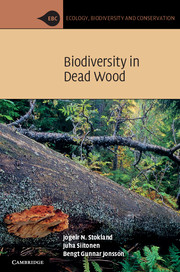Book contents
- Frontmatter
- Contents
- Preface
- 1 Introduction
- 2 Wood decomposition
- 3 The saproxylic food web
- 4 Other associations with dead woody material
- 5 Host-tree associations
- 6 Mortality factors and decay succession
- 7 Microhabitats
- 8 Tree size
- 9 The surrounding environment
- 10 Evolution of saproxylic organisms
- 11 Species diversity of saproxylic organisms
- 12 Natural forest dynamics
- 13 Dead wood and sustainable forest management
- 14 Population dynamics and evolutionary strategies
- 15 Threatened saproxylic species
- 16 Dead wood in agricultural and urban habitats
- 17 The value and future of saproxylic diversity
- References
- Index
1 - Introduction
Published online by Cambridge University Press: 05 June 2012
- Frontmatter
- Contents
- Preface
- 1 Introduction
- 2 Wood decomposition
- 3 The saproxylic food web
- 4 Other associations with dead woody material
- 5 Host-tree associations
- 6 Mortality factors and decay succession
- 7 Microhabitats
- 8 Tree size
- 9 The surrounding environment
- 10 Evolution of saproxylic organisms
- 11 Species diversity of saproxylic organisms
- 12 Natural forest dynamics
- 13 Dead wood and sustainable forest management
- 14 Population dynamics and evolutionary strategies
- 15 Threatened saproxylic species
- 16 Dead wood in agricultural and urban habitats
- 17 The value and future of saproxylic diversity
- References
- Index
Summary
This book is about life in dead trees. All over the world one can find a fascinating diversity of life forms in decaying wood – first and foremost a wide variety of fungi and insects. These organisms carry out the hidden but highly important work of wood decomposition.
A fundamental question frequently revisited in this book is: ‘Why is the species diversity of wood-inhabiting organisms so tremendously high?’ In most chapters we approach this question indirectly by highlighting the key properties of dead wood, along with the environmental factors and processes that bring about the diversity we can observe. We also discuss species richness explicitly in Chapter 11. There are at least two good reasons for addressing the biodiversity in dead wood. One is that the diversity of wood-inhabiting organisms is a multifaceted and interesting phenomenon that deserves attention for its own sake. Another reason is that this diversity is being seriously threatened due both to the loss and fragmentation of forests and because of the greatly reduced amount of dead wood in managed forests and other woodlands. Thus, we need to understand the role of dead wood for biodiversity in order to manage and maintain it while efficiently utilizing forest resources.
- Type
- Chapter
- Information
- Biodiversity in Dead Wood , pp. 1 - 9Publisher: Cambridge University PressPrint publication year: 2012
- 2
- Cited by



